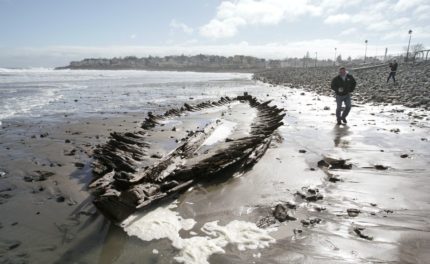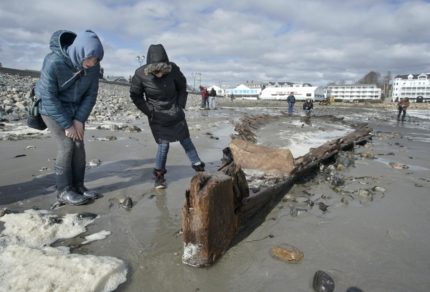An unknown ship whose skeletal remains have haunted a beach in York, Maine for 70 years may have been identified as a Colonial-era schooner. First emerging from the sands after a brutal nor’easter in 1958, the shipwreck appears every few years when exposed by storms. Its most recent appearance was after the 2018 bomb cyclone.
The 51-foot keel, the broken ribs and a few planks are all that remain of the ship, making identification difficult and very little is known about the ship. When it was first exposed, locals thought it might be a pinky schooner, a small fishing boat with a pinched bow that was in common use on the New England coast from the early 18th century well into the early 20th.
Experts thought its dates might be narrowed down to the late Colonial through early post-Colonial period, ca. 1750 to 1850. Now a researcher thinks he’s identified far more precisely it as the Defiance, a 60-foot sloop, (a single-masted sailing vessel) built in Massachusetts in 1754. It was recorded as having washed to shore in York during a storm in 1769.
Funded by the Maine Historical Commission, researcher Stefan Claesson embarked on the first scholarly study of the wreck. To narrow down its age, Claesson sent samples of the wood from the wreck to the Cornell University Tree-Ring Laboratory which was able to compare the dendrochronology of the timbers to the New England tree-ring index. The trees the wreck samples were taken from had been felled in 1753.
He then scoured archives to find ships that washed ashore in York around that time. The likeliest candidate was the sloop Defiance, whose history also matched the dendrochronological evidence.
Records from the 18th century show that Defiance was sailing out of Salem, Massachusetts for Portland, Maine, according to Claesson.
The ship was carrying a cargo of flour, pork and English goods along with a four-man crew. But the ship encountered a fierce storm.
“They took anchor, but in heavy seas the crew was forced to cut the anchor cables, and they were pushed ashore onto York Beach,” Claesson said. “The ship was a total loss, but the crew survived.”
Claesson’s discovery is significant because it’s one a very few examples of a pre-Revolutionary War ship built in New England, he said. But also because it can reveal the increase and impact of storm events and sea level rise.
“Shipwrecks like this can also be thought of as living organisms, or environmental warehouses, that store and can reveal information about regional climate variations through study of tree rings. In this initial study, we now have tree-ring data for multiple species from the early 1600s to the 1750s,” Claesson said.
The wreck site is owned by the town of York, but it has not been treated with much reverence, I’m afraid. Whenever it has appeared, beachcombers have walked on its planks, clambered over its ribs, taken photos and much worse, taken pieces of wood as “souvenirs.” As a significant historical find, the wreck could qualify for the National Registry of Historic Places and further studies could reveal much more about the skeleton ship if it is properly protected from human predators. The elements are foe enough.

